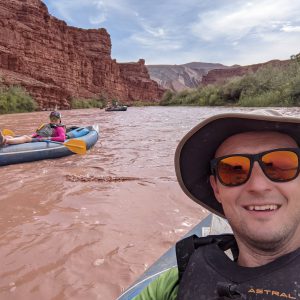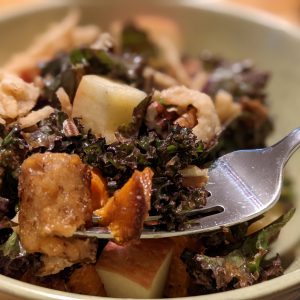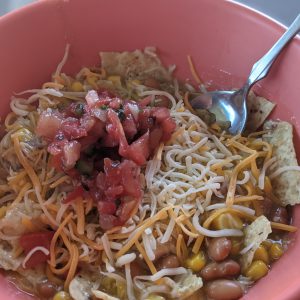When we got married we registered at two places: Target and REI. We figured between the two we had all our bases covered. (We’re the kind of people who value backpacking gear over fancy dinnerware.) We’d both done a lot of camping with family and friends, Noel’s an Eagle Scout and my parents started taking me camping when I was only a few months old, but never together and never with either one of us running the show. Before our first trip we did a trial run tent setup in the backyard, erecting our brand new tent with the speed and precision of a Nascar pit crew. We were feeling pretty smug about our amazing outdoor skills, until we left the tent unstaked in the yard for a few minutes and returned to find it in the neighboring parking lot. Its formerly pristine rainfly torn in multiple places from its end over end journey across the asphalt. We sheepishly repacked the tent, hoping it wasn’t a bad omen. At the time we were poor college students so we were constantly looking for financial corners to cut. Our meal plan was minimal so it consisted mainly of PB&Js and canned soup. We quickly grew tired of the PB&Js and the first night we made soup we melted the rubber seal on the lid of our rented cookware, launching us into our first memorable fight. My stubborn pride quickly dismissed Noel’s suggestion that we go out to eat and so we went to bed irritated, sweaty, and hungry. We survived the rest of our trip, but I’m afraid our hangriness made it so we weren’t able to properly enjoy all that Arches National Park had to offer.
Now, our purpose in camping isn’t to eat gourmet, but recreational camping trips needn’t resemble Lord of the Flies or “To Build a Fire.” (Although wilderness survival skills are worth learning in case you do find yourself in such a situation.) Having a substantial amount of food in a pleasing variety can really make the difference between a tale of survival and one of the best vacations ever. We now have several backpacking and car camping trips under our belt including four years of camping with kids. This Summer we’re going to have an on-going series called “Camp Kitchen” where we’ll be sharing our favorite camp kitchen approved recipes with you. To kick it off here are our top tips for eating well in an outdoor kitchen.
 1. Prepare as much as you can at home. Look through your recipes, if there’s something that can be done at home instead of at camp, do it. I chop up vegetables and fruit, measure out dry ingredients, and marinate my meat beforehand so by the time I get to camp it’s like I’m on a cooking show with everything in pre-measured
1. Prepare as much as you can at home. Look through your recipes, if there’s something that can be done at home instead of at camp, do it. I chop up vegetables and fruit, measure out dry ingredients, and marinate my meat beforehand so by the time I get to camp it’s like I’m on a cooking show with everything in pre-measured bowls ziplocs.
2. Bring plenty of snacks. If you are properly camping, you’ll find you’re being more active than you usually are on average, which means you’ll need more fuel. This also means you’ll be dipping into the hanger danger zone more frequently so you’ll want to have plenty of snacks on hand for moments when the kids are screaming (or maybe you are) and you can’t even get the charcoal to light let alone dinner on the table in any reasonable amount of time. We try to pack as many homemade snacks as possible, but we also allow ourselves more “prepackaged splurges” than we do on a regular basis.
 3. Invest in quality, practical equipment. We don’t own a ton of gadgets, but most of what we do own has multiple purposes. We’ve justified a lot of our gear purchases as emergency preparedness items. When the items aren’t in use they live in our 72 hours kits (AKA backpacking backpacks) just in case. Our complete camp kitchen consists of a backpacking stove, water filter, two dutch ovens (not part of backpacking gear), charcoal chimney, an old pair of tongs, a dutch oven lid lifter, a compact cooking set, a cooler, a set of roasting sticks, and whatever utensils we decide we needed for a particular trip.
3. Invest in quality, practical equipment. We don’t own a ton of gadgets, but most of what we do own has multiple purposes. We’ve justified a lot of our gear purchases as emergency preparedness items. When the items aren’t in use they live in our 72 hours kits (AKA backpacking backpacks) just in case. Our complete camp kitchen consists of a backpacking stove, water filter, two dutch ovens (not part of backpacking gear), charcoal chimney, an old pair of tongs, a dutch oven lid lifter, a compact cooking set, a cooler, a set of roasting sticks, and whatever utensils we decide we needed for a particular trip.
4. Print out your recipes. Smart phones are awesome and I’m completely addicted to mine, but don’t count on them when food and wilderness combine.
 5. Practice at home. Dutch oven food is delicious no matter where you’re eating it so don’t relegate it to camping only. Charcoal won’t damage concrete (although it will leave a bit of a mess to clean up) so you don’t even need a firepit. If you are a dutch oven novice doing a dry run at home is a great idea so you can build your confidence for when you’re at camp.
5. Practice at home. Dutch oven food is delicious no matter where you’re eating it so don’t relegate it to camping only. Charcoal won’t damage concrete (although it will leave a bit of a mess to clean up) so you don’t even need a firepit. If you are a dutch oven novice doing a dry run at home is a great idea so you can build your confidence for when you’re at camp.
6. Have a backup plan. Sometimes despite all your good intentions things just don’t go the way you planned. Bring a little extra food or keep a nearby restaurant in the back of your mind just in case.
 7. Don’t forget to incorporate all food groups. Growing up my dad always gave embarrassing lectures on our camping trips on the importance of eating non-constipatory foods. I really wish I was joking about that. It does seem that fruits and vegetables often get neglected when it comes to camping and hiking, but it’s important to remember them. Melons travel well (to camp, not up a mountain, obviously). We’ve also had good experience with apples and strawberries (in sturdy containers). More delicate fruits like bananas, peaches, and nectarines can be easily bruised and don’t fare as well. As for vegetables, we try to incorporate them into our meals in addition to snacking on carrots, celery sticks, etc.
7. Don’t forget to incorporate all food groups. Growing up my dad always gave embarrassing lectures on our camping trips on the importance of eating non-constipatory foods. I really wish I was joking about that. It does seem that fruits and vegetables often get neglected when it comes to camping and hiking, but it’s important to remember them. Melons travel well (to camp, not up a mountain, obviously). We’ve also had good experience with apples and strawberries (in sturdy containers). More delicate fruits like bananas, peaches, and nectarines can be easily bruised and don’t fare as well. As for vegetables, we try to incorporate them into our meals in addition to snacking on carrots, celery sticks, etc.
 8. Avoid or limit gimmicks. You’ll probably see a lot of “cute” ideas on the internet for campfire cooking. If you must try them, narrow it down. I remember a church camping trip from my youth where every meal involved cooking pancakes on tin cans with tea lights or boiling eggs in ziploc bags. It was painful and I was hungry a lot of the time. It may seem like a novel idea, but isn’t it easier to just make regular scrambled eggs over some hot coals or on a camp stove?
8. Avoid or limit gimmicks. You’ll probably see a lot of “cute” ideas on the internet for campfire cooking. If you must try them, narrow it down. I remember a church camping trip from my youth where every meal involved cooking pancakes on tin cans with tea lights or boiling eggs in ziploc bags. It was painful and I was hungry a lot of the time. It may seem like a novel idea, but isn’t it easier to just make regular scrambled eggs over some hot coals or on a camp stove?
 9. Pack smart. You want to make sure you cover all your bases, but you also want to make sure your food leaves room for the rest of your gear. Compress things as much as possible. If an item is in unnecessary packaging, remove it. If a ziploc can be used instead of a tupperware, do it. If you’re using condiments, pick up packets from a deli or gas station instead of bringing 10 bottles with you. Prepping your meals as much as you can at home can also greatly reduce the amount of space your food takes up. Freezing prepped food can also decrease the amount of ice you need in your cooler which gives you a little more stuffing space.
9. Pack smart. You want to make sure you cover all your bases, but you also want to make sure your food leaves room for the rest of your gear. Compress things as much as possible. If an item is in unnecessary packaging, remove it. If a ziploc can be used instead of a tupperware, do it. If you’re using condiments, pick up packets from a deli or gas station instead of bringing 10 bottles with you. Prepping your meals as much as you can at home can also greatly reduce the amount of space your food takes up. Freezing prepped food can also decrease the amount of ice you need in your cooler which gives you a little more stuffing space.
10. Verify amenities. It is always a good idea to see if there is a fire ban where you’re going so you don’t get stuck eating cold hotdogs. Also check on the availability of water, grill grates, and other things you might need like ice or firewood. Making one extra phone call can really save you a lot of suffering.
 Bonus Tip: Introduce one new element at a time. Completely overhauling your routine can be overwhelming and potentially disastrous. We only ever try one new meal item at a time. We also plan to only have one “difficult” menu item per evening. For example, we’d grill kabobs and make a dutch oven cobbler one night and the next we would make a main dish in the dutch oven, but have s’mores for dessert.
Bonus Tip: Introduce one new element at a time. Completely overhauling your routine can be overwhelming and potentially disastrous. We only ever try one new meal item at a time. We also plan to only have one “difficult” menu item per evening. For example, we’d grill kabobs and make a dutch oven cobbler one night and the next we would make a main dish in the dutch oven, but have s’mores for dessert.
What tips do you have for the camp kitchen?






Hello! Just discovered your new blog via pinterest! Looks great! I’ve let my blog stalking fall by the wayside but I’ll try and stop by (especially if you continue to pin…that’s where I spent most of my spare time).
We will continue to pin; happy you found us!
Awesome! I’ll probably be giving this post a shout out in the near future.
We’d appreciate the love!
[…] at this point you smile, kick back, and read a good book for a while because you have all your ingredients pre-measured and mixed in ziploc bags. If that’s not the case this is a good time to start chopping or mixing […]
[…] I always try to follow rule #7 of Camp Kitchen 101, I think this trip was my most successful attempt so far and I had to share. It took some careful […]